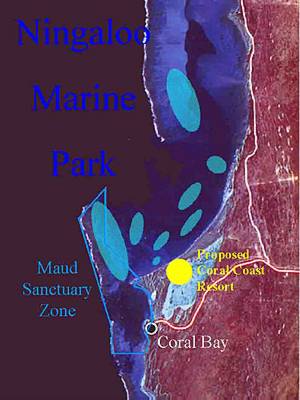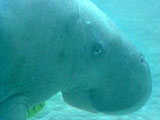
Dugong
 |
Halophila (seagrass) beds in the vicinity of the proposed resort. Dugong numbers are in steep decline elsewhere in the Indian Ocean. |

As the dugong is the only member of its genus and family its genes hold more value than that of most other species (Preen, 1998), making dugong conservation essential. Australia provides one of the last strongholds for the worldwide dugong population (Marsh et al, 1999) as it is the only place where the mammal is present in substantial numbers (Preen, 1998). Throughout their range in the rest of the world, dugongs occur as isolated populations separated by large areas where they are as good as extinct (Preen, 1998). This means that there is no exchange of genes between populations. The genetic diversity of dugongs is particularly high in Australian waters (Marsh et al, 1999). High genetic diversity is essential for the long-term survival of a population. For these reasons, conservation measures in Australia are almost certainly crucial for the future survival of dugongs (Preen, 1998).
THREATS
The major threat to dugongs from a development such as that proposed for Maud's
Landing will be loss of habitat during the construction phase and the increased
human presence once construction has ceased. Dugongs feed exclusively on seagrasses,
which are very sensitive to human disturbances. The construction process associated
with the development will increases the turbidity of the surrounding ocean area.
This acts to reduce the light available to seagrass communities, causing their
decline (Marsh et al, 1999). If nutrient levels of the water increase from their
present levels, epiphytic growth on the seagrass will be encouraged. This will
also act to limit the light reaching the seagrass (Marsh et al, 1999).
An increased number of boats in Bateman Bay and the surrounding ocean area will greatly increase the likelihood of dugongs colliding with boats. Such collisions can be fatal. Dugongs are known to be quite shy creatures, so it is possible that an increased human presence could see them disappear from the area altogether. Dugongs are very sensitive to pollution, particularly oil pollution that can be sourced from boats (Marsh et al, 1999). In addition, dugongs could get caught in discarded fishing line or other litter.
Due to the fact that dugongs are long-lived animals with a very low reproductive
rate, threats to their survival have a particularly profound effect on the population
as a whole (Marsh et al, 1999). If dugong mortality brought about by human impacts
exceeds 1% to 2% of females per year, the dugong population in question will
decline (Preen, 1998). This highlights how fragile dugong populations are and
how important it is that the population at Ningaloo is conserved.
REFERENCES
Marsh, H., Eros, C., Corkeron, P. and Breen, B. 1999, 'A conservation strategy for dugongs: implications of Australian research', Marine and Freshwater Research, vol. 50, pp. 979 - 990.
Preen, A. 1998, 'Marine protected areas and dugong conservation along Australia's Indian Ocean coast', Environmental Management, vol. 22, no. 2, pp. 173 - 181.
Preen, A.R., Marsh, H., Lawler, I.R., Prince, R.I.T. and Shepherd, R. 1997, 'Distribution and abundance of dugongs, turtles, dolphins and other megafauna in Shark Bay, Ningaloo Reef and Exmouth Gulf, Western Australia', Wildlife Research, vol. 24, pp. 185 - 208.